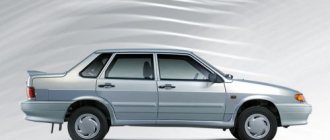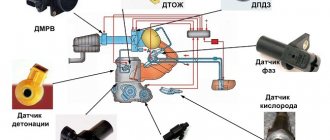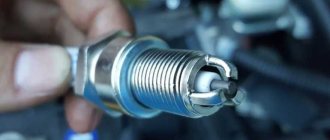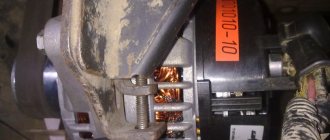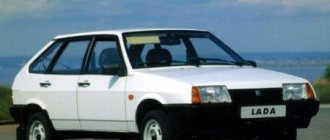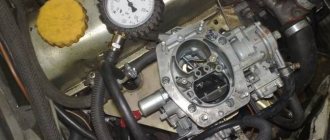VAZ-2112 is a compact car manufactured in 1999, produced at the AvtoVAZ plant in Tolyatti. The hatchback of the same name is one of the modifications of the “ten” VAZ-2110 in a sedan body. A station wagon was also produced on the basis of this model. The car was produced until 2008; on the VAZ-2112 assembly line it was replaced by the more modern Lada Priora hatchback, which is the successor to the entire “tenth” family. In addition to the five-door hatchback, the VAZ-2112 also had a three-door Coupe modification. This version was produced in limited edition.
VAZ 2112 in detail about fuel consumption
When buying a car, the owner is interested in the question of fuel consumption. The fuel consumption of the VAZ 2112 16 in comparison with other models of this car brand is considered economical and acceptable. But it is worth considering that even the driver depends on gasoline consumption for a certain distance. To understand this issue in more detail, it is necessary to consider all the reasons and nuances that affect the decrease or increase in fuel consumption. The actual fuel consumption of the Lada 2112 in the city is approximately 8 liters per 100 kilometers.
If your car's engine uses more fuel, then you need to find out all the direct factors that influence this.
VAZ 2112 1.6 8cl. 81 hp
The version with the VAZ-21114 engine received the factory index VAZ-21211. It was a 1.6-liter 8-valve fuel-injected engine capable of producing 81 hp. and a torque of 129 Nm. The engine had a number of shortcomings, so after some time it was replaced by a more reliable and economical 16-valve modification.
Reviews about fuel consumption of VAZ 2112 1.6 8kl. 81 hp
- Roman, Sochi. I bought it from one representative of the mountain people in 2012 - it was tuned to the best of my ability, forward flow, ProSport optics, new seats, lowered suspension, low-profile tires, completely noise-free, and the like. It roars like a beast, and the engine is a regular 1.6-liter 8-valve engine. In general, there is an external gloss, but there is little sense. Consumption 8-9 liters, up to 10 maximum. I drove it for six months and sold it to the same “ara-tuning” lover as the one from whom I bought it.
- Alexey, Slavyansk-on-Kuban. I bought my VAZ-2112 in 2003. I took it with a 1.6 liter engine - I think it is better than 1.5 liters. I drove it for almost 10 years – it was like my own. An excellent car for the city and suburbs, fuel consumption is up to 9 liters, on the highway generally 6 liters.
- Nikolay, Ulyanovsk. Lada “twelfth”, 2004, with a 1.6 liter eight-valve engine. At first I was delighted after the purchase, but very, very soon I had an epiphany. The only plus is the high ground clearance and that’s it. Everything else is rare hemorrhoids. The interior is completely miserable, everything rattles and knocks, something constantly breaks, and normally no one repairs this squalor at all. Gasoline consumption is normal - 8-9 liters consistently in the city, on the highway 6.5 liters.
- Maxim, Noyabrsk. Don't be fooled by the fact that spare parts can be bought at any store. Yes, you can buy them there - but they are of even worse quality than Chinese ones. You buy, install, and after two or three months you have to buy and install again. And so on with each node. The only thing they did right was the ground clearance; they made it quite high for our roads. Expected consumption – highway from 5.5 to 6.5 liters, city from 7 to 10 liters.
- Grigory, Bratsk. Everyone complains about the domestic auto industry, but I like the “two-wheeler”. I bought it back in 2006 - a three-year-old VAZ-2112 with an 8-valve 1600 cc. A couple of years later I sold it and took the same one, but 16v. I will say that I didn’t see much of a difference either in consumption or in dynamics - my first “two-wheeler” was peppy and consumed 7-8 liters of gasoline on average in the city.
Average fuel consumption values for VAZ 2112
When purchasing a car, you must immediately know the average fuel consumption of the engine under three main conditions.
| Engine | Consumption (highway) | Consumption (city) | Consumption (mixed cycle) |
| 1.5 5-mech | 5.5 l/100 km | 9.1 l/100 km | 7.6 l/100 km |
| 5.5 l/100 km | 8.8 l/100 km | 7.2 l/100 km |
The first is the fuel consumption of the VAZ 2112 on the highway, which averages from 9 to 10 liters. In rural areas, off-road - from 9.5 liters. In a combined cycle, fuel consumption on a VAZ 2112 should be at least 7.7 liters. If your VAZ car requires much more, then you should pay attention to the following points:
- like driving style;
- engine's type;
- car mileage;
- specifications;
- fuel quality.
Driving maneuverabilityVAZ
The first thing auto mechanics advise you to pay attention to when fuel consumption is high is your driving style. Lada is a car that does not tolerate slow acceleration or slow acceleration.
Engine type VAZ
The 2112 hatchback has a 1.6-liter fuel-injected engine with 16 valves. A 5-speed manual transmission is installed. For such an engine, the fuel consumption of the VAZ 2112 (16 valves) is an average of 7.7 liters.
As for the engine type. If the VAZ 2112 fuel consumption per 100 km exceeds 8 liters, then you need to pay attention:
- fuel filter;
- valve filter;
- nozzles;
- candles;
- valve;
- oxygen sensor.
You should also check the condition and adjustment of the electronics and its reliability.
You should measure the compression in the cylinders. When compression decreases, engine power decreases and in order to achieve the dynamics we are accustomed to we have to press harder on the trigger, and hence increased consumption. Reasons for decreased compression: wear of the cylinder-piston group, leaky fit of the valves to the seats, coking of the piston rings. If in the first two cases you can’t do without opening and repairing the engine, then in the third case, at the early stage of coking of the piston rings, you can use a decoking agent, for example “LAVR-anticoke”. The MAF (mass mass sensor) can also tell you about the condition of the piston group air flow) on an injection engine, provided that it is in good condition. It is enough to connect the computer and compare the current readings of the sensor with the readings that should be for a specific ECU (electronic engine control unit), for example: ECU January 4.1 at an engine speed of 750-850 should consume air 7-8 kg/hour, if the values are lower, then this can already indicate wear of the cylinder-piston group; the lower the reading, the greater the wear.
Black carbon deposits on the spark plugs indicate an enriched fuel mixture; in this case, the fuel does not burn completely and the remains of unburned fuel fly out into the pipe, and therefore increased consumption. True, to say that the fuel does not burn completely due to the enriched composition of the fuel mixture is not entirely true; it would be more honest to say that in such a situation less fuel is burned than it should be, since in a fully operational, naturally aspirated engine, roughly speaking, half of the incoming fuel is burned fuel. Reasons for over-enrichment of the fuel mixture: for a carburetor engine - the air filter is clogged, the carburetor is clogged or incorrectly adjusted, for an injection engine - the air filter is clogged, incorrect readings of the mass air flow sensor, incorrect readings of the DTOZh sensor (coolant temperature sensor). There is one more malfunction that will affect the over-enrichment of the fuel mixture, although I don’t know how relevant it is for a carburetor engine, but it will definitely affect the fuel consumption of the injector. This malfunction is a thermostat in which the valve opens completely, earlier than it should, in this case, the engine will not heat up to the required operating temperature, the ECU sees that the engine is not warmed up and will supply a rich mixture.
Light carbon deposits on the spark plugs mean that the fuel mixture is lean; here a similar situation arises as with a decrease in compression, engine power decreases. For a carburetor engine, the reason for a lean mixture lies again in a malfunction, blockage, or incorrect adjustment of the carburetor. The injector has: sensors - mass air flow sensor and air pressure sensor, low pressure in the fuel line. Low pressure occurs when the fuel pump is worn out, when the fuel pump strainer is clogged, or when the fuel filter is clogged.
Other reasons for increased fuel consumption due to the fault of the injector fuel system: the fuel return valve does not work, the injectors are leaking, the injectors are clogged - because of this, the injectors do not atomize the fuel well, and as a result, the quality of the fuel mixture is poor, which reduces engine dynamics.
And if your fuel consumption has increased in winter, this is normal. Reasons: increased engine warm-up time, increased load on the engine due to an increase in the viscosity of the oil in the engine and gearbox, the same thing happens with the grease in the bearings of hubs and grenades, rapid cooling of the engine, the interior heater is constantly running, frequent wheel slipping on snow and ice. Winter fuel consumption is definitely higher than when operating in a warm period; consumption may increase slightly, or it may be shocking. For example, I have a VAZ 2110 1.5 injector, fuel consumption per 100 km, when driving long distances, increases by 1-2 liters, and when driving short distances of 2-5 km, fuel consumption doubles. At the same time, my summer consumption is according to my passport.
Fuel consumption is also affected by an increase in the weight of the car, for example, they set the music to 50 kilograms, flat tires, the tires themselves, incorrect wheel alignment, and driving style.
Car mileage
A very important point is the mileage of the car, as well as its condition. If this is a new car from a showroom, then all average fuel consumption indicators should match. If the car’s mileage has exceeded 100 thousand kilometers, then gasoline consumption may exceed the average.
It also depends on where the car was driven, on what roads, at what pace, and whether the engine was repaired. To find out exactly what gasoline consumption on a VAZ 2112 will be under your driving mode, fill the tank with 1 liter and check how far you can drive. Car mileage is the total number of kilometers that the car has traveled without repairing the engine and its main components.
Machine Specifications
A Russian passenger car with a hatchback body with easy maneuverability, it has fairly good factory technical characteristics. In order for fuel consumption to remain constant and not increase, it is necessary to monitor the technical characteristics of the entire vehicle. Inspection at service stations, as well as computer diagnostics will help you with this.
Fuel quality
The fuel consumption at idle speed of the VAZ 2112 is affected by the quality of gasoline, as well as the ketone number of the liquid being refilled. An experienced driver can safely say that he noticed how fuel consumption changed not depending on driving style
, not from the engine or even from the filters, but from high-quality fuel. When driving a VAZ 2112, you should take into account its mileage, as well as what you put in the tank. Accordingly, the amount of fuel consumption is determined from this.
How to regulate fuel consumption on a VAZ 2112
We have already considered the factors and reasons that affect the use of gasoline in the VAZ 2112. Now you need to know what needs to be done to prevent gasoline consumption from increasing or how to reduce it. The main points to prevent increased fuel consumption are:
- constantly change the fuel filter;
- monitor the operation of the engine system;
- change candles that become black and oily over the years - non-functional;
- watch the condition of the fuel pump mesh so that it does not fall into the glass;
- The catalyst and exhaust must function.
By adhering to these rules, you can save on fuel costs for the VAZ 2112 by 7.5 liters.
Basic rules for reducing gasoline consumption
An attentive driver must constantly monitor all indicators of the car. Monitor the oil level, monitor engine operation, and monitor all filters and strainers. If you bought a car that has already traveled a certain number of kilometers and its fuel consumption exceeds 10 liters, then you should immediately take the following actions:
- change oil (adjust level);
- replace the filter;
- check the quality of gasoline;
- observe the performance of the fuel pump;
- regulate driving maneuverability.
If all this does not lead to the desired result, then you need to do computer diagnostics of the car.
Fuel consumption rate for VAZ 2112
The fuel consumption per 100 km recorded during operation of the VAZ-2112 hatchback is one of the characteristics that determines the technical condition of the car. Fuel efficiency is influenced by various factors, but with a calm driving rhythm, the parameter may differ from the factory values by 10-15% upward. If fuel consumption exceeds 10-12 liters per 100 kilometers, it is necessary to check the sensors of the gasoline injection control system.
Characteristics of VAZ-2112
The VAZ-2112 car was positioned by the plant as a model with increased dynamic characteristics; initially, the cars used in-line 4-cylinder power units with fuel injection (carburetor versions were not offered). The equipment was equipped with 5-speed manual transmissions with front-wheel drive (the gear ratio of the main pair depends on the engine model). The all-metal body (shortened compared to the sedan) is designed for a driver and 4 passengers, the luggage compartment is closed with a lift-up lid.
The hydraulic brake system with a vacuum booster remains unchanged (discs are installed at the front, drum mechanisms are used at the rear). The VAZ plant mass-produced the car from 1998 to 2008, abandoning further production in Ukraine under the Bogdan brand.
The cars were equipped with rack and pinion steering without hydraulic power steering. The standard equipment included a cabin ventilation unit with a heating radiator, and a small number of cars were equipped with air conditioning. Basic versions had manual window drives in the front doors; on expensive versions, electric windows were offered. The car had a low level of passive safety; the design was not designed to install airbags or an anti-lock braking system in the brake drive.
Since 2002, the 3-door Lada-21123 coupe, based on the body of the 2112 car, has been produced in small series since 2002. The cars used only 16-valve engines with a volume of 1.6 or 1.8 liters; according to the main technical parameters, models with 3 and 5 doors were no different.
The coupe had a body with increased torsional rigidity, which further improved handling. Assembly of the model ceased in 2009.
VAZ 2112 1.6 16 cl. 89 hp
The latest and most popular model is the VAZ-2112, equipped with a VAZ-21124 engine. This is an injection 4-cylinder engine with a volume of 1597 cm3, having 4 valves per cylinder. The engine developed a power of 89 hp. and a torque of 133 Nm. It has a modernized design that eliminates the main problems of the 8-valve version, in particular the problem with valve bending
Fuel consumption VAZ 2112 1.6 16 cl. 89 hp per 100 km. Reviews
- Alexey, Chelyabinsk. Sixteen-valve VAZ-2112, 2005. I bought it new, sold it five years later and don’t regret the purchase or sale one bit. During all this time I hardly bothered you, but five years is the deadline for the domestic automobile industry, then sex with the car begins, and why spoil the impression? So I sold it and am happy. By the way, its consumption is less than that of the “ten” - on average I got 6.5 liters in the city, but I drive calmly.
- Timur, Pervouralsk. VAZ-2112, 2007, engine 1.6 16V, 90 hp. For the money, the car is not bad - it’s really made for our roads, and it looks more interesting than the “ten”. But the build quality is a quiet horror - everything that can rattles. In terms of consumption - highway 5.5 l, city 8.5 l, in winter maximum 10 l.
- Semyon, Krivoy Rog. Before the “Dvenakh” there was the Volga 29 - you can’t compare them at all. “Dvenakha” in comparison with it is just some kind of foreign car. I bought it in 2012, four years old. The condition is normal - as normal as it can be for our car. Consumption is from 7 to 10 liters, there is Shumka, nothing particularly knocked. I took it while I was riding and am happy.
- Artem, Salavat. A really simple and problem-free car, no matter what anyone says. Probably one of the most successful AvtoVAZ models. At speed the car is stable, does not throw it, the power of the 16-valve engine is enough for the eyes. Another plus is the high ground clearance; some city crossovers have lower ground clearance. Well, it’s economical - on the highway the consumption is 5.5 liters, in the city from 7 to 9 liters.
- Vitaly, Anzhero-Suzhensk. I bought my VAZ-2112 2007 six months ago. I haven’t really gotten into it yet - I made a Shumka, installed good acoustics, and also replaced the steering rack. There are no problems with consumption - if you heat in the city, then nine liters is the maximum, but if it’s calm - then six or seven liters, no more.
- Kirill, Abakan. "Dvenakha" 2006. Consumption is from 6 to 8 liters per 100 km, and in the city, if you don’t heat it, it’s very economical. In winter, consumption increases by about 2-3 liters, depending on frost.
- Anton, Tyumen. I always liked the “Dvenashki” - but the first time I bought a bad one, it turned out to be after a serious accident, it was hastily adjusted and that’s it, but I wanted to buy a car so much that I didn’t look carefully - I was attracted by the price. Six months later I realized the mistake, but I liked the model itself. Therefore, when choosing the next “two-piece”, I looked more carefully and made the right decision. What I like most about it is the engine - a reliable and simple sixteen-valve engine, it worked like a clock, even though the car is from 2007. If they did the same for the bodies, there would be no price. Consumption is normal - on the highway up to 6 liters, in the city up to 10 liters.
- Mikhail, Volgograd. I believe that if you buy a VAZ, you don’t need to show off and spoil it with collective farm tuning. The car is already normal - a good and inexpensive means of transportation, there is no need to make a circus out of it. Yes, the build quality is not great, the finishing materials are very cheap - and for the price it’s not a Rolls-Royce or even a Toyota. An ordinary car for the average citizen of our country. But everyone can afford it - spare parts are cheap and consumption ranges from 7 to 10 liters.
- Pavel, Samara. I drove a VAZ-2112 for a year and realized that cheap spare parts do not mean cheap maintenance - it means that you will constantly buy spare parts for the car, and they will constantly break down. Over the course of a year, I repaired the entire chassis, oil system, and went through the electrical system. After the consumption jumped to 15 liters in the city, I finally saw the light - it turned out that the air flow sensor burned out, I had to buy a new one so that the consumption dropped to 10 liters. In general, the car is for a novice driver.
- Roman, Izhevsk. My VAZ-2112 with a 1.6 16-valve engine is the most economical car I've ever owned. Consumption on the highway is 5.5 liters in total, in the city a maximum of 11.5 liters (this is in winter). The model with this engine is truly the most successful.
What engines are installed on the VAZ-2112
The following engines were installed as standard on the vehicles:
- basic 8-valve 2111 with a volume of 1.5 liters and a power of 77 hp. With. (the modification was distinguished by the use of solid front brake discs without ventilation ducts);
- the improved version of the GLI used a 91-horsepower engine 21120 (16 valves, 2 camshafts, volume 1.5 l);
- after the modernization of power plants in 2004, the base models began to be equipped with an 82-horsepower 1.6-liter engine 21114 with an 8-valve valve timing;
- since 2004, a 16-valve 21124 with a volume of 1.6 and a power of 89 hp began to be used. With. with a modified piston group and an improved crankshaft;
- cars with a 1.8-liter 21128 were assembled in small batches (power 98 or 123 hp, depending on the settings of the control unit and the profile of the camshaft cams).
All power units are built on the basis of a unified 4-cylinder block; a liquid cooling system with forced circulation of antifreeze is used to maintain the required temperature. Until 2004, a sports modification of the 112-37 hatchback, equipped with a boost of up to 100 hp, was assembled in small batches. With. engine 21120. The cars were distinguished by the design of the box with a locked differential, the interior was equipped with sports seats with seat belts and a welded frame made of pipes to protect the driver in case of rollover.
Depending on the year of manufacture, engines use different exhaust manifolds. Until 2004, the catalytic converter was installed separately, the exhaust toxicity complied with Euro-2 standards. With the start of production of 1.6-liter power plants, a manifold with an integrated catalyst and 2 oxygen concentration sensors began to be installed (the toxicity standard increased to the Euro-3 standard). Removing the neutralizer reservoir from under the underbody made it possible to increase the ground clearance by 10 mm.
The engines are equipped with a forced ignition system with electronic adjustment of the spark timing. On 8-valve models and the 21120 engine, a common module is used with coils connected by wires to the spark plug tips.
The 21124 power unit uses individual coils inserted into the spark plug wells on the gas distribution mechanism cover.
VAZ 2112 1.5 8v, 1.8
Other power units were also installed on VAZ-2112 cars. The first models were equipped with an injection 8-valve 1.5-liter VAZ-2111 engine, which had successfully proven itself on models of the “ninth” series, capable of producing power of 77 hp.
In addition, a modification of the VAZ-21128 was produced in a small series. It was equipped with a powerful 1.8-liter injection engine capable of producing 105 hp. and a torque of 162 Nm. Without exception, all engines were equipped with a 5-speed manual transmission.
Official fuel consumption rate for VAZ 2112
The gasoline consumption declared by the plant (in l/100 km) is presented in the table.
| Motor model | Power, l. With. | City mode | Country mode | Combined cycle |
| 2111 | 77 | 10,0 | 5,7 | 7,3 |
| 21120 | 91 | 9,4 | 5,9 | 7,4 |
| 21114 | 82 | 10,0 | 6,0 | 7.4 |
| 21124 | 89 | 9,4 | 5,9 | 7,5 |
| 21128 | 98 | 9.8 | 6.1 | 8,5 |
The consumption rates and power of power plants published by the VAZ manufacturer depend on the year of manufacture of the car (the discrepancy does not exceed 0.1-0.2 liters). The output of early 21120 engines was 94 hp. s., later due to modernization the parameter dropped to 92 or 91 liters. With. A similar situation arises with the 2111 engines; early models had a power of 79 hp. With.
Regardless of the volume and year of manufacture, the engines are designed to use gasoline with an octane rating of at least 95 units.
Official data (l/100 km)
| Engine | Consumption (city) | Consumption (highway) | Flow (mixed) |
| 1.5 MT 72 hp (Mechanics) | 9.0 | 5.6 | 7.3 |
| 1.5 MT 78 hp (Mechanics) | 10.0 | 5.7 | 7.3 |
| 1.5 MT 92 hp (Mechanics) | 9.8 | 6.1 | 7.4 |
| 1.5 MT 94 hp (Mechanics) | 9.4 | 5.9 | 7.1 |
| 1.6 MT 81 hp (Mechanics) | 10.0 | 6.0 | 8.5 |
| 1.6 MT 90 hp (Mechanics) | 9.4 | 5.9 | 7.1 |
| 1.8 MT 98 hp (Mechanics) | 10.0 | 6.0 | 8.5 |
The VAZ 2112 was equipped with several types of engines. In fact, there were only three of them, but due to various modifications their power varied greatly. The first engine is 1.5 liters. The version, which had a total of 8 valves, could develop a power of 72 horsepower. Fuel consumption per 100 km here was at around 7.2 liters. The 16-valve version showed slightly more power – 92 hp. Gasoline consumption for this configuration was also around 7 liters.
The next engine is 1.6 liters. The eight-valve configuration produces 81 horsepower, and the sixteen-valve configuration produces 90 hp. These engines have increased consumption, prescribed at 8 liters. Well, the largest engine is 1.8 liters. It has only one version, with a capacity of 98 horsepower. Its average consumption was 8.5 liters. All engines were paired with only a manual transmission operating in five modes.
Fuel consumption at idle
When working with a stationary vehicle, fuel consumption depends on the following factors:
- cylinder block and throttle body temperatures;
- condition of injector nozzles and air filter;
- settings of the program recorded in the memory of the control unit;
- general condition of the engine piston group and gas distribution mechanism;
- degree of load on the crankshaft.
For example, the fuel consumption of a VAZ-21124 during a cold start in winter (temperature -20°C) reaches 1.5 liters per hour. As the engine warms up, the control unit adjusts the mixture composition, reducing the parameter to the standard 0.7-0.8 liters. Turning on electrical consumers (for example, a powerful sound system or high beam headlights along with fog lights) increases the load on the generator and automatically increases the idle consumption to 1-1.1 liters per hour.
Real fuel consumption figures for VAZ 2112
When operating the machine, fuel consumption differs from that declared by the factory for a number of reasons:
- driving style;
- loads;
- chassis condition;
- quality of fuel filled;
- serviceability of the catalytic converter and oxygen sensors;
- condition of spark plug electrodes;
- correct adjustment of the gas distribution mechanism.
Injector 1 5 l for 16 valves (92 l s)
Fuel efficiency of cars with engine 21120:
- In city driving mode during quiet acceleration, the engine burns within 10-11 liters; in winter, 1-2 liters more are required (due to the need to warm up or travel short distances at low engine temperatures, additional traffic and slippery road surfaces). With an aggressive driving style with sharp acceleration, fuel consumption is in the range of 12-14 liters per 100 km.
- On the highway at a speed of 90-100 km/h, the car requires 6.5-7.0 liters of gasoline; when working with a trailer or when the cabin is fully loaded, consumption increases to 8 liters. At a speed of 120-130 km/h, the car burns at least 8 liters of fuel; when accelerating to 140-150 km/h, the parameter reaches 9-9.5 liters.
With petrol engine 1 6 (89 l s)
When using the improved unit 21124, fuel costs are:
- When operating the car in a city with a large number of traffic lights and traffic jams, the consumption does not exceed 9.5 liters (according to the on-board computer); in small settlements, the engine only needs 8.5 liters of gasoline. In winter, costs increase by 0.5-1.0 liters during quiet driving and trips over a distance of more than 10 km (with full heating of the cooling system).
- On a suburban highway, with smooth acceleration and maintaining a speed within 90-95 km/h, it is possible to keep within 5.5 liters of fuel (there are a driver and a passenger in the cabin). When the load increases or the speed increases, the value increases to 7-8 liters.
Outdated VAZ-21114 engine
On cars equipped with an 8-valve engine 21114, the consumption during actual operation is:
- In summer, in urban conditions, fuel consumption, according to reviews from owners, is within 9 liters per 100 km. Low power does not allow dynamic acceleration of the car; if you operate the accelerator pedal carelessly, efficiency drops by 1 liter. In winter, the engine consumes from 10 to 12 liters (depending on climatic conditions in the region of operation).
- On the highway, the engine requires from 6 to 7 liters at a speed of 90 km/h and 7-8 liters when accelerating to 110-120 km/h.
8-valve VAZ-2111 engine 1 5 l
On early versions of cars with a model 2111 engine, fuel costs are:
- On cars with a worn piston group and transmission, consumption in city traffic reaches 11 liters; on vehicles in good technical condition, the parameter drops to 9-9.5 liters.
- For suburban use, the car can be filled with 5.5 liters of gasoline, provided it is driven at a speed of 80-90 km/h with a minimum load (driver and passenger). When fully loaded and the speed increases to 100-110 km/h, the parameter reaches 6.5-7 liters.
VAZ 2112 1.5 16 valve 92 hp
Since 2001, VAZ-2112 cars in the VAZ-21120 version have been equipped with a 1.5-liter VAZ-21120 injection 16-valve engine. This engine developed 92 hp. and a torque of 133 Nm and was considered one of the most popular engines in the LADA 110 family. The engine was paired with a 5-speed manual transmission.
Gasoline consumption VAZ 2112 1.5 16 valve 92 hp per 100 km. Reviews
- Alexey, Moscow. I bought the car in 2013 - it was my first car. I didn’t show off too much, I took the domestic auto industry - a VAZ-2112, with a one and a half liter 16v engine. For the money it's a normal car, if you don't worry about it and take care of it. I've already driven 40 thousand km on it - it's inexpensive to repair, the main thing is that it's not the engine. Consumption is quite high - in the city on average 9 l/100 km, and if you drive - then all 12 liters.
- Oleg, Prokopyevsk. I took the VAZ-2112, “born” seven years ago, for one simple reason - my RAV4 broke down, and for a long time. So we had to look for a car to go to work, and... All the money went into repairs - I had to take it cheaper. I was surprised that in fact the car turned out to be not as wretched as everyone thinks - yes, it is much inferior in terms of comfort, but it didn’t break down much, and carried me in any weather without problems. Consumption is quite reasonable - from 6 liters on the highway to 12 liters if you want to drive around the city.
- Mikhail, Moscow. I love my “two-piece”, which I bought in 2007. I took it from the first owner - a car produced in 2003, with a 1.5 l 16v engine, 90 horses. It was completely stock, but I put a lot of effort and money into making it into a sweetie. By the way, I’ll say right away that the car drives without problems for five years, but then everything starts to break down at once. Fuel consumption depends very much on how you drive. If you calmly and without putting pressure on your slippers, it’s stable 7.5-8.0 liters per hundred square meters. If you heat it - 12 liters safely.
- Evgeniy, Kazan. I purchased the “twelfth” at the beginning of 2014 - my first car after passing my license. I drove it for six months and sold it - that’s what I had to do. I’m completely satisfied - maintenance is much cheaper than foreign cars, and gasoline consumption averages ten liters per hundred kilometers in the city.
- Sergey, Mezhdurechensk. Fuel consumption of the VAZ-2112 greatly depends not only on driving style, but also on the time of year. For comparison, if in the summer in the city there is a stable 8-9 liters, then in the winter it’s never less than 12, or even 15 liters if it’s frosty. On the highway, by the way, it doesn’t really matter – 5.5 in summer, 6.0 in winter.
- Kamil, Novokuibyshevsk. VAZ-2112, engine 1.5 16V, 90 hp, 2004. The downside is that upon purchase the body began to rust, and after six months the rest of the sores appeared. But we are not afraid of difficulties - the car has been in the garage for six months and is as good as new - all that remains is to make the body. Consumption on average is 6.5 -7.5 liters per hundred square meters, no more.
- Anatoly, Barnaul. The car, like the entire domestic auto industry, is rare guano. Maybe I got one - but it’s just tough. I bought it in 2010, manufactured in 2000. It’s clear that it’s old, but even an old car can’t break down like that. I suffered with it for about a year, threw the same amount into it as I bought it for and barely sold it at a loss. Plus it consumes a lot of gasoline - in the city it’s at least 9 liters, on the highway about 7 liters.
